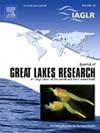Intraspecific variation in stable isotopes provides insight into adfluvial migrations and ecology of brook trout in Lake Superior tributaries
IF 2.4
3区 环境科学与生态学
Q3 ENVIRONMENTAL SCIENCES
引用次数: 0
Abstract
Identifying streams hosting salmonids with poorly understood adfluvial life histories, such as coaster brook trout, is challenging due to the lack of inexpensive, non-lethal techniques for confirming lake to stream movements for stream-captured fish. In this study, we used stable isotope data from 589 brook trout collected throughout the Lake Superior basin to characterize stream versus Lake Superior foraging. We observed strong isotopic separation in δ13C between brook trout inhabiting Lake Superior and lake-inaccessible stream reaches (i.e., those lacking Lake Superior access). Using these data, we developed a linear discriminant function (LDF) which assigned brook trout to Lake Superior or stream habitats with over 97 % accuracy. LDF and Bayesian stable isotope mixing models were then used to estimate stream and lake energy use by brook trout collected from lake-accessible reaches. Brook trout caught in lake-accessible reaches had isotope signatures and sizes that were intermediate to fish from lake-inaccessible reaches and Lake Superior, potentially indicative of Lake Superior to stream migrations or possibly an energy subsidy from adfluvial migrants in streams. The LDF was used to estimate the probability that recently grown fin tissue from brook trout collected in lake-accessible reaches resulted from foraging in Lake Superior. We identified tributaries hosting “likely” coaster brook trout using a fish’s length and LDF probability value. Our findings show the potential and limitations of this approach for confirming adfluvial migrations of brook trout.
稳定同位素的种内变化提供了对苏必利尔湖支流溪鳟河流迁移和生态的深入了解
由于缺乏廉价的、非致命的技术来确认河流捕获的鱼类从湖泊到河流的运动,因此确定河流中鲑鱼的河流生活史(如过山车溪鳟)具有挑战性。在这项研究中,我们使用了在苏必利尔湖流域收集的589条溪鳟的稳定同位素数据来表征溪流与苏必利尔湖觅食的特征。我们观察到居住在苏必利尔湖和湖泊不可达河段(即没有苏必利尔湖通道的河段)的鳟鱼δ13C同位素分离较强。利用这些数据,我们开发了一个线性判别函数(LDF),将布鲁克鳟鱼分配到苏必利尔湖或溪流栖息地,准确率超过97%。然后使用LDF和贝叶斯稳定同位素混合模型来估计从湖泊可达河段收集的溪鳟对河流和湖泊的能量利用。在湖泊可达河段捕获的鳟鱼的同位素特征和大小介于湖泊不可达河段和苏必利尔湖之间,这可能表明苏必利尔湖对河流洄游的影响,或者可能是溪流中河流洄游的能量补贴。LDF用于估计在湖泊可达河段收集的小溪鳟鱼最近生长的鳍组织是由于在苏必利尔湖觅食造成的可能性。我们使用鱼的长度和LDF概率值确定了“可能”承载过山车溪鳟的支流。我们的研究结果表明,这种方法的潜力和局限性,以确认小溪鳟鱼顺流迁移。
本文章由计算机程序翻译,如有差异,请以英文原文为准。
求助全文
约1分钟内获得全文
求助全文
来源期刊

Journal of Great Lakes Research
生物-海洋与淡水生物学
CiteScore
5.10
自引率
13.60%
发文量
178
审稿时长
6 months
期刊介绍:
Published six times per year, the Journal of Great Lakes Research is multidisciplinary in its coverage, publishing manuscripts on a wide range of theoretical and applied topics in the natural science fields of biology, chemistry, physics, geology, as well as social sciences of the large lakes of the world and their watersheds. Large lakes generally are considered as those lakes which have a mean surface area of >500 km2 (see Herdendorf, C.E. 1982. Large lakes of the world. J. Great Lakes Res. 8:379-412, for examples), although smaller lakes may be considered, especially if they are very deep. We also welcome contributions on saline lakes and research on estuarine waters where the results have application to large lakes.
 求助内容:
求助内容: 应助结果提醒方式:
应助结果提醒方式:


